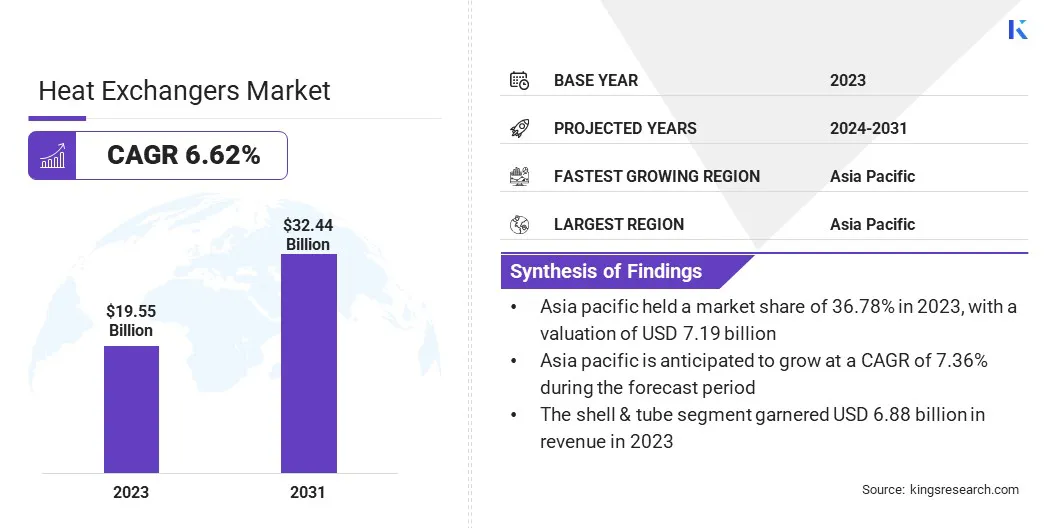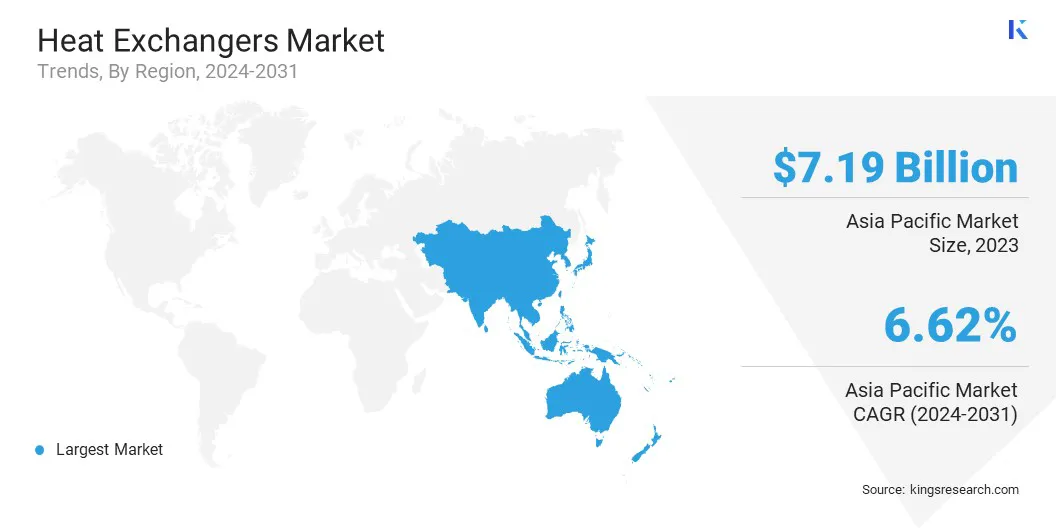Buy Now
Heat Exchangers Market Size, Share, Growth & Industry Analysis, By Product (Plate & Frame, Shell & Tube, Air-cooled, Others), By Material (Hastelloy, Titanium, Nickel & Nickel Alloys, Tantalum, Steel, Others), By End-User, and Regional Analysis, 2024-2031
Pages: 190 | Base Year: 2023 | Release: February 2025 | Author: Sunanda G.
A heat exchanger is a device designed to efficiently transfer heat from one fluid (liquid or gas) to another without mixing them. It is commonly used in heating, cooling, and energy recovery applications across industries such as HVAC, power generation, chemical processing, and automotive engineering.
Heat exchangers operate through various mechanisms, including conduction and convection, and come in different types, such as shell-and-tube, plate, and finned-tube heat exchangers, each suited for specific applications based on heat transfer efficiency, pressure drop, and maintenance requirements.
Global heat exchangers market size was USD 19.55 billion in 2023, which is estimated to be valued at USD 20.71 billion in 2024 and is projected to reach USD 32.44 billion by 2031, growing at a CAGR of 6.62% from 2024 to 2031.
The growth of the global market is driven by rising energy efficiency requirements, expanding industrial sectors, and the growing use of renewable energy. Industries are adopting waste heat recovery systems to reduce energy consumption, propelled by rising demand in power generation, chemical processing, and HVAC applications.
Additionally, the shift toward sustainable technologies, including hydrogen and carbon capture systems, is supporting market expansion.
Major companies operating in the heat exchangers market are ALFA LAVAL, Danfoss, Güntner GmbH & Co. KG, API Heat Transfer, HISAKA WORKS, LTD., Xylem, Mersen, Kelvion Holding Gmbh, GEA Group Aktiengesellschaft, Linde PLC, Johnson Controls, SPX FLOW, Metalforms, LLC, General Electric Company, Tranter, Inc., and others.
The increasing focus on energy conservation across industries is boosting the growth of the market. These systems enhance energy efficiency by optimizing heat transfer processes, reducing fuel consumption, and minimizing operational costs. The growing adoption of energy recovery solutions in power plants, industrial facilities, and HVAC systems is fueling market expansion.

Market Driver
"Surging Need for HVAC Sytems in Several Applications"
The increasing need for heating, ventilation, and air conditioning (HVAC) systems in residential, commercial, and industrial sectors is significantly contributing to the growth of the heat exchangers market.
These are essential components in chillers, heat pumps, and air conditioning units, ensuring efficient temperature regulation and energy conservation. The rising demand for cold storage solutions and refrigeration systems in the food and pharmaceutical industries further supports market expansion.
Market Challenge
"High Initial Investment and Maintenance Costs"
The substantial upfront costs associated with heat exchangers, including manufacturing, installation, and maintenance expenses, present a major challenge to market growth.
Advanced technologies, particularly in nuclear and renewable energy applications, require high-quality materials and precision engineering, further increasing costs and hampering the growth of the heat exchangers market.
To address this challenge, companies are investing in research and development to create cost-effective, durable, and energy-efficient heat exchangers. The adoption of advanced manufacturing techniques, including 3D printing and automation, is reducing production costs.
Additionally, companies are offering predictive maintenance solutions using IoT and AI to enhance operational efficiency and minimize long-term maintenance expenses.
Market Trend
"Rising Global Investments in Nuclear Energy"
Increasing investments in nuclear power as a reliable and low-carbon energy source are increasing demand for heat exchangers. Governments and private entities are expanding nuclear capacity to meet growing electricity needs while reducing reliance on fossil fuels.
This surge in nuclear power plant construction is highlighting the need for efficient heat exchange systems for cooling and thermal management.
| Segmentation | Details |
| By Product | Plate & Frame (Gasketed Plate Heat Exchangers, Brazed Plate Heat Exchangers, Welded Plate Heat Exchangers), Shell & Tube (Fixed Tube Sheet, Floating Head, U-Tube), Air-cooled (Forced Draft, Induced Draft), Others |
| By Material | Hastelloy (Hastelloy C-22, Hastelloy C-276, Hastelloy X), Titanium (Grade 1 Titanium, Grade 2 Titanium, Grade 5 Titanium), Nickel & Nickel Alloys (Inconel, Monel, Alloy 600/625), Tantalum (Pure Tantalum, Tantalum Alloys), Steel (Stainless Steel, Carbon Steel, Duplex Steel), Others |
| By End-User | Chemical & Petrochemical (Chemical Processing, Refineries, Fertilizers & Agrochemicals, Specialty Chemicals), Oil & Gas (Upstream , Midstream , Downstream), HVAC & Refrigeration (Residential HVAC, Commercial HVAC, Industrial Refrigeration), Power Generation (Thermal Power Plants, Nuclear Power Plants, Renewable Energy), Food & Beverage (Dairy Processing, Beverages & Brewing, Meat & Poultry Processing, Confectionery & Bakery), Pulp & Paper (Paper Mills, Pulp Processing), Others |
| By Region | North America: U.S., Canada, Mexico |
| Europe: France, U.K., Spain, Germany, Italy, Russia, Rest of Europe | |
| Asia-Pacific: China, Japan, India, Australia, ASEAN, South Korea, Rest of Asia-Pacific | |
| Middle East & Africa: Turkey, UAE, Saudi Arabia, South Africa, Rest of Middle East & Africa | |
| South America: Brazil, Argentina, Rest of South America |
Market Segmentation:
Based on region, the global market has been classified into North America, Europe, Asia Pacific, Middle East & Africa, and Latin America.

The Asia Pacific heat exchangers market share stood around 36.78% in 2023 in the global market, with a valuation of USD 7.19 billion . The expansion of refining and petrochemical projects in countries such as China, India, and Southeast Asia is creating a strong demand for heat exchangers.
These industries rely on efficient heat transfer equipment for crude oil processing, LNG liquefaction, and gasification operations. Rising foreign investments and joint ventures in refining capacity expansion are further supporting regional market growth.
Europe heat exchangers industry is poised to grow at a robust CAGR of 7.36% over the forecast period. With rapid urbanization and stringent energy efficiency regulations, the adoption of advanced heating, ventilation, and air conditioning (HVAC) systems is growing across residential, commercial, and industrial sectors.
The rising demand for heat pumps, supported by European Union (EU) policies promoting electrification and decarbonization of heating, is significantly contributing to market growth. Heat exchangers are essential in heat pump systems, ensuring optimal thermal efficiency.
Furthermore, the region is witnessing significant developments in nuclear energy. For instance, in February 2025, Belgium's new government is considering doubling its nuclear capacity from 4 gigawatts (GW) to 8 GW by constructing new reactors. This move underscores the country's commitment to expanding its nuclear energy infrastructure.
Companies in the heat exchangers industry are actively forming strategic partnerships to integrate advanced technologies that enhance energy efficiency and reduce carbon emissions. These collaborations focus on developing innovative materials, optimizing heat recovery systems, and improving the thermal performance of exchangers to support sustainability goals.
By partnering with research institutions, energy companies, and material suppliers, manufacturers are advancing low-carbon solutions and aligning with global decarbonization initiatives.
Recent Developments (New Product Launch)
Frequently Asked Questions